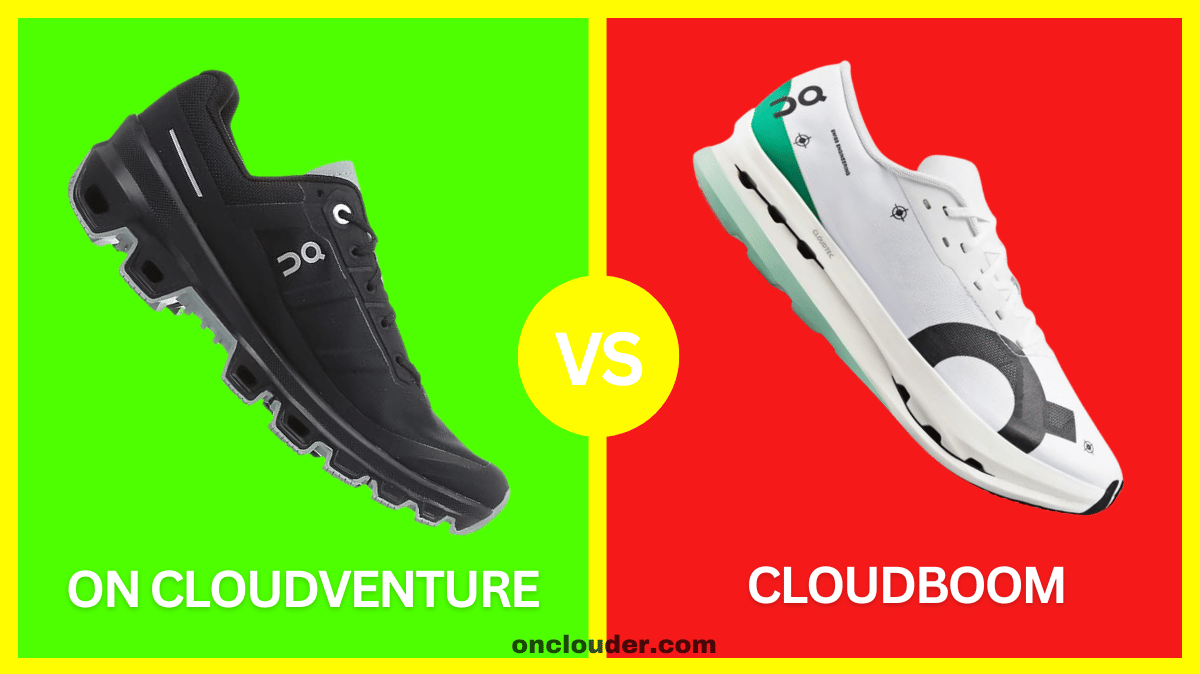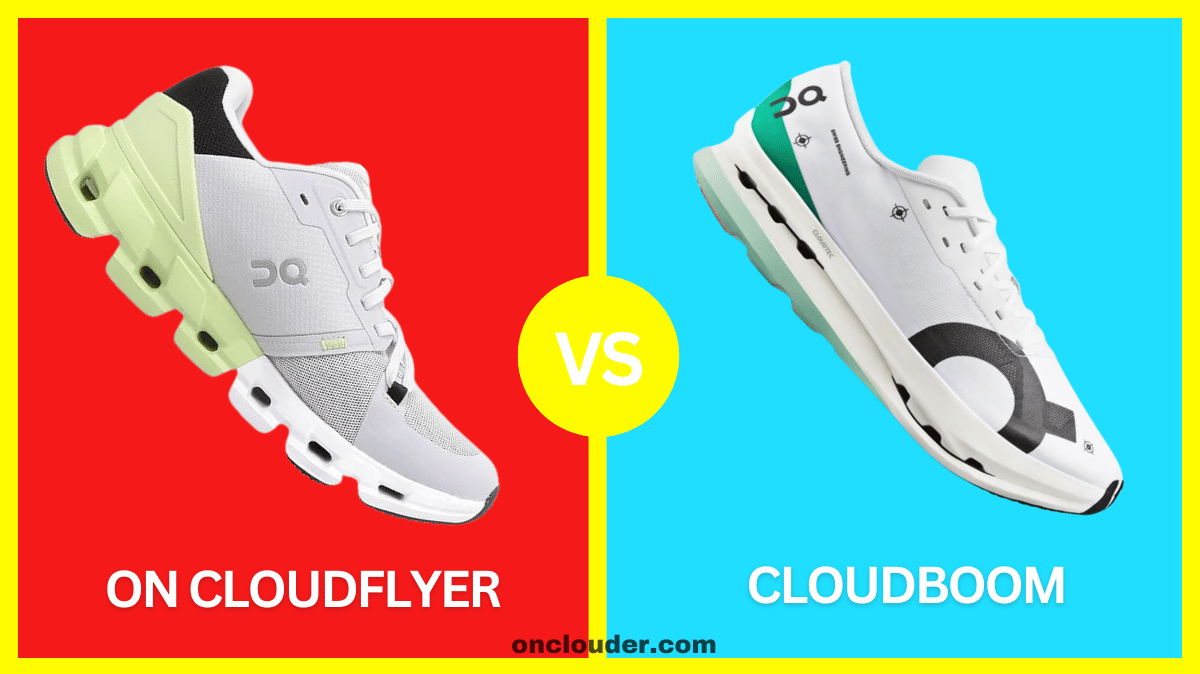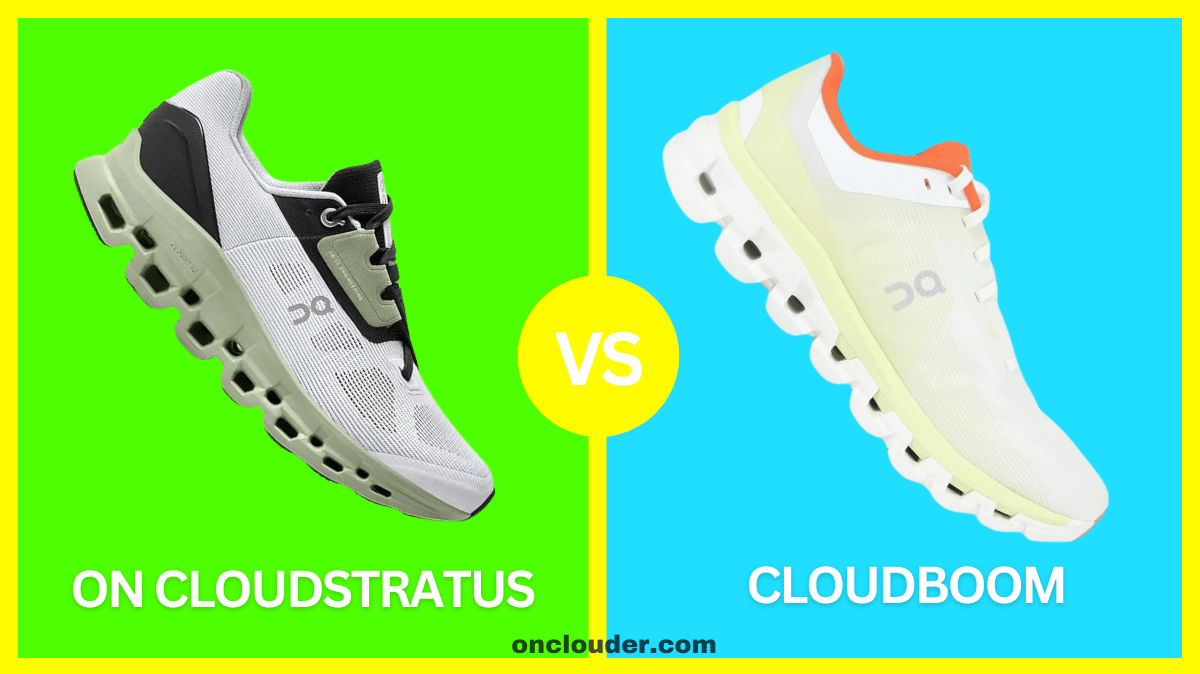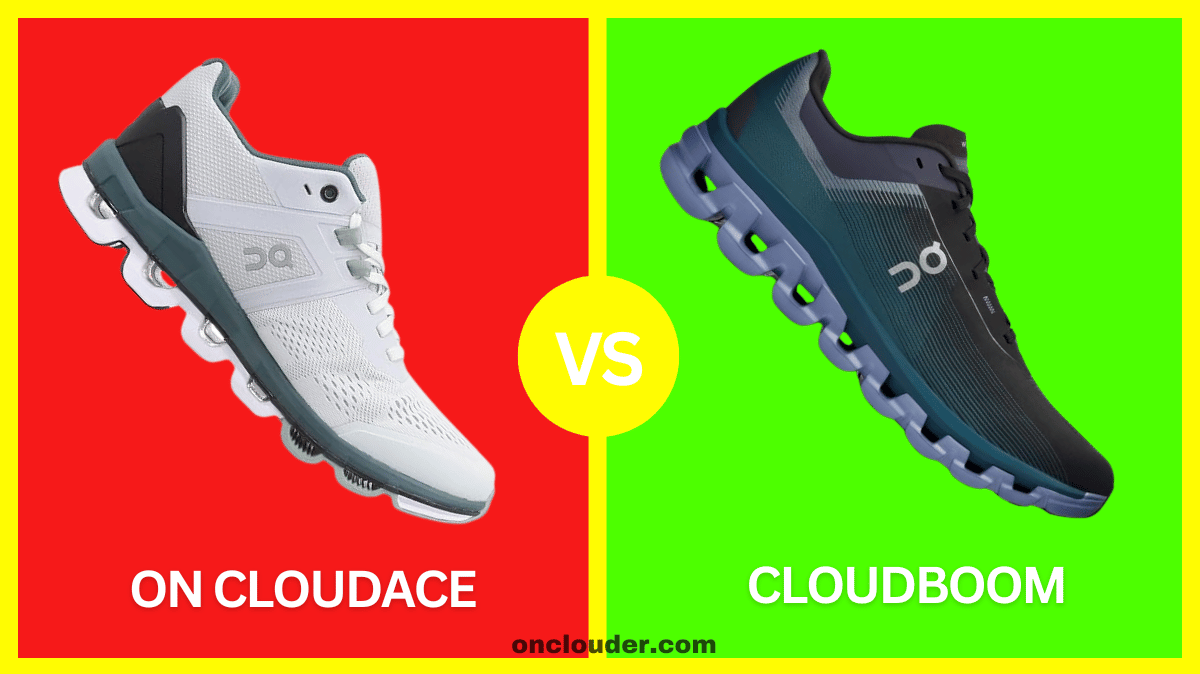Are you ready to learn about two awesome shoes from On Running? Today, we’re going to compare the On Cloudventure and the Cloudboom.
These shoes might sound like they’re from outer space, but they’re actually designed to help you run your best here on Earth!
Let’s dive in and see what makes each of these shoes special.

Contents
- 1 Quick Comparison: On Cloudventure vs Cloudboom Shoes
- 2 What Are These Shoes All About?
- 3 Durability: Built to Last?
- 4 Breathing Room: Let Your Feet Breathe!
- 5 Cushioning: Soft Landings Ahead
- 6 Shoe Fit: Finding Your Perfect Match
- 7 Stability: Staying Steady on Your Feet
- 8 Comfort: Happy Feet, Happy Runner
- 9 Quality: Built to Perform
- 10 Style: Looking Good on the Run
- 11 Size: Finding the Right Fit
- 12 Material: What Are These Shoes Made Of?
- 13 Weight: Light on Your Feet
- 14 Flexibility: Bend and Flex
- 15 Water Resistance: Staying Dry
- 16 Sole: Where the Rubber Meets the Road (or Trail)
- 17 User Reviews: What Do Other Runners Think?
- 18 Price: What’s the Damage?
- 19 Pros and Cons
- 20 Conclusion
- 21 Frequently Asked Questions
Quick Comparison: On Cloudventure vs Cloudboom Shoes
The main difference between On Cloudventure and Cloudboom shoes is their intended use. Cloudventure is made for trail running, with tough materials and good grip for rough terrain.
Cloudboom is designed for road racing, being super light and fast. Cloudventure is better for outdoor adventures, while Cloudboom helps you zoom on smooth roads.
| Feature | On Cloudventure | On Cloudboom |
| Best for | Trail running | Road racing |
| Weight | Heavier (about 295 grams) | Lighter (about 220 grams) |
| Durability | Very durable for rough terrain | Less durable, made for speed |
| Breathability | Good, with water drainage | Excellent, very thin upper |
| Cushioning | Soft, for long runs | Firm, for fast runs |
| Fit | Roomy, especially in toe box | Snug, like a second skin |
| Stability | Wide base for trail stability | Carbon plate for speed stability |
| Comfort | Very comfy for long trail runs | Less cushy, made for short races |
| Style | Tough, outdoorsy look | Sleek, race-ready look |
| Size | Usually true to size | Might need to go up half a size |
| Materials | Tough mesh, durable rubber | Thin mesh, light rubber |
| Flexibility | Balanced flex for trails | Stiffer for speed |
| Water Resistance | Some resistance, drains well | Not water-resistant |
| Sole | Deep lugs for trail grip | Smooth for road speed |
| Price | $150 – $170 | $200 – $220 |
In summary: On Cloudventure and Cloudboom are two different shoes for different types of running. Cloudventure is tough and grippy, perfect for running on trails and in nature. It’s comfy for long runs and can handle rocks and mud. Cloudboom is super light and fast, made for racing on roads. It helps you run really fast but isn’t as comfy for long runs.
Cloudventure is better if you like running outdoors and on rough paths. Cloudboom is better if you want to run really fast on smooth roads or in races. Both shoes are good, but they’re made for different things. Choose the one that matches what kind of running you like to do!
Also Read: On Cloudflyer vs Cloudboom
What Are These Shoes All About?
Before we start our shoe showdown, let’s get to know our contenders a little better.
On Cloudventure: Your Trail Running Buddy
The On Cloudventure is like your trusty sidekick for outdoor adventures. It’s made for running on trails, which means it can handle bumpy paths, rocky hills, and even muddy tracks. If you love exploring nature while you run, this shoe might be your new best friend!
On Cloudboom: Your Speed Machine
The On Cloudboom, on the other hand, is all about speed. It’s designed for road running and racing. If you dream of zooming past your friends on the track or setting new personal records on the street, the Cloudboom could be your ticket to victory.
Now that we know what these shoes are for, let’s see how they stack up against each other in different areas.
Durability: Built to Last?
When you’re picking out shoes, you want them to last a long time, right? Let’s see how our two contenders do in the durability department.
Cloudventure: The Tough Cookie
The Cloudventure is like the tough kid on the playground. It’s built to handle all sorts of rough terrain. The shoe has special reinforcements in areas that usually get worn out quickly, like the toe and heel. This means you can run over rocks and through mud without worrying about your shoes falling apart.
Cloudboom: The Sleek Speedster
The Cloudboom isn’t as rugged as the Cloudventure, but it’s still pretty tough. It’s made to withstand the repeated impact of running on roads. However, because it’s designed to be super light for racing, it might not last as long as the Cloudventure if you use it for everyday running.
Breathing Room: Let Your Feet Breathe!
Nobody likes sweaty, stinky feet. That’s why it’s important for shoes to let air flow through them. This is called breathability. Let’s see how our shoes do in this area.
Cloudventure: Cool and Collected
The Cloudventure has a mesh upper that lets air flow freely. This means your feet can stay cool and dry, even when you’re running up steep trails on a hot day. The shoe also has drainage ports, which are like little escape hatches for water if you happen to step in a puddle.
Cloudboom: Light and Airy
The Cloudboom takes breathability to the next level. It has an ultra-thin, almost see-through mesh upper that lets tons of air in. This keeps your feet cool during fast runs and races. However, this super breathable design might not be great if you’re running in cold or wet conditions.
Cushioning: Soft Landings Ahead
Cushioning is like having tiny pillows under your feet. It helps absorb the shock when your foot hits the ground. Both of our shoes have cushioning, but they use it in different ways.
Cloudventure: Comfort for the Long Haul
The Cloudventure uses On’s special CloudTec cushioning. It’s like having a bunch of tiny clouds under your feet. These “clouds” compress when you land and then spring back when you push off. This gives you a soft landing and a bouncy takeoff, which is great for long runs on tough trails.
Cloudboom: Speedy and Responsive
The Cloudboom also uses CloudTec, but in a different way. Its cushioning is firmer and more responsive. This means it doesn’t squish as much when you land, but it gives you more energy back when you push off. It’s perfect for fast runs where you want to feel connected to the ground.
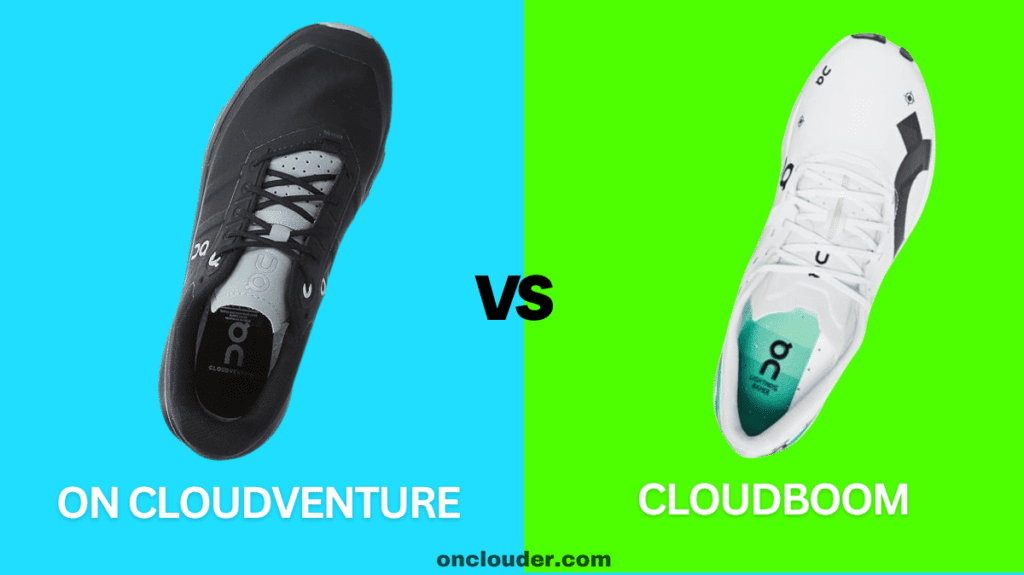
Shoe Fit: Finding Your Perfect Match
Getting the right fit is super important. A shoe that fits well can help you run better and avoid blisters. Let’s see how our two shoes fit.
Cloudventure: Roomy and Secure
The Cloudventure has a roomier fit, especially in the toe box (that’s the part where your toes go). This gives your toes space to spread out, which can help with balance on uneven trails. The shoe also has a secure heel cup to keep your foot in place when you’re running up or down hills.
Cloudboom: Snug and Speedy
The Cloudboom has a snugger fit all around. It’s designed to feel like a second skin, hugging your foot closely. This can help you feel more connected to the ground and make quick direction changes easier. However, if you have wider feet, you might find the Cloudboom a bit too narrow.
Also Read: On Cloudstratus vs Cloudboom
Stability: Staying Steady on Your Feet
Stability is all about keeping you balanced and preventing your ankles from rolling. This is especially important when you’re running on uneven ground.
Cloudventure: Your Trail Balancing Act
The Cloudventure is designed with trail stability in mind. It has a wider base than the Cloudboom, which gives you a more stable platform. The shoe also has deep lugs (those are the bumpy parts on the bottom of the shoe) that dig into the ground and give you better traction on slippery or loose surfaces.
Cloudboom: Stable at Speed
The Cloudboom doesn’t need as much stability features because it’s made for running on flat roads. However, it does have a carbon fiber plate in the midsole. This plate helps keep your foot stable and gives you a snappy toe-off for faster running.
Comfort: Happy Feet, Happy Runner
Comfort is king when it comes to running shoes. After all, you’re going to be spending a lot of time in them! Let’s see how comfy our two shoes are.
Cloudventure: Cozy on the Trails
The Cloudventure is built for comfort over long distances on rough terrain. It has extra padding around the ankle and in the tongue to prevent rubbing and blisters. The CloudTec cushioning also helps absorb impact, making your run more comfortable even on rocky trails.
Cloudboom: Fast and Functional
The Cloudboom prioritizes speed over plush comfort. It’s not uncomfortable, but it’s designed to be lightweight and responsive rather than super cushy. Some runners find it very comfortable for fast runs, while others prefer it for shorter distances.
Quality: Built to Perform
When we talk about quality, we’re looking at how well the shoe is made and how it performs its job. Both of our shoes are high-quality, but in different ways.
Cloudventure: Trail-Tested Toughness
The Cloudventure shows its quality in its durability and performance on trails. The materials used are top-notch and designed to withstand the abuse of trail running. The shoe’s ability to protect your feet from rocks and roots while still providing a comfortable ride is a testament to its quality.
Cloudboom: Racing Excellence
The Cloudboom’s quality shines in its innovative design and performance features. The carbon fiber plate and specialized foam are cutting-edge technologies designed to help you run faster. The shoe’s ability to maintain its performance characteristics over many miles of fast running shows its high quality.
Also Read: On Cloudace vs Cloudboom
Style: Looking Good on the Run
While performance is most important, it’s always nice to have shoes that look cool too!
Cloudventure: Rugged Good Looks
The Cloudventure has a tough, outdoorsy look that matches its purpose. It comes in a variety of colors, from earthy tones to brighter options. The visible CloudTec pods on the sole give it a unique appearance that stands out on the trails.
Cloudboom: Sleek and Swift
The Cloudboom has a more streamlined, race-ready look. Its thin upper and sculpted sole give it a fast appearance even when it’s standing still. It typically comes in lighter colors to keep you cool during races.
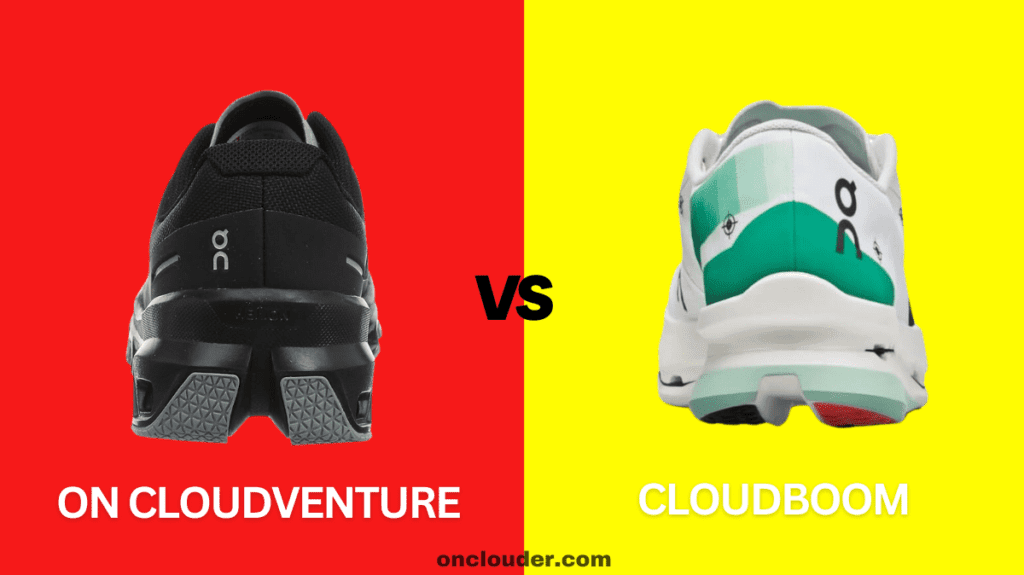
Size: Finding the Right Fit
Getting the right size is crucial for comfort and performance. Here’s what you need to know about sizing for these shoes.
Cloudventure: True to Size
The Cloudventure generally runs true to size. This means if you usually wear a size 7, a size 7 in the Cloudventure should fit you well. However, because it has a roomier toe box, some people with narrow feet might prefer to go down a half size.
Cloudboom: Snug Fit
The Cloudboom tends to run a bit small and narrow. Many runners find they need to go up a half size from their usual size. If you have wide feet, you might even need to go up a full size.
Material: What Are These Shoes Made Of?
The materials used in a shoe can affect its performance, durability, and comfort. Let’s take a look at what our shoes are made of.
Cloudventure: Tough and Protective
The Cloudventure uses durable materials to withstand trail conditions:
- Upper: Made of a tough mesh that lets air in but keeps debris out
- Midsole: Features On’s Helion superfoam for cushioning
- Outsole: Uses Missiongrip rubber for excellent traction on various surfaces
Cloudboom: Light and Fast
The Cloudboom uses lightweight, performance-oriented materials:
- Upper: Ultra-thin, breathable mesh
- Midsole: Helion superfoam combined with a carbon fiber plate
- Outsole: Lightweight rubber placed only in high-wear areas
Weight: Light on Your Feet
The weight of your shoes can affect how fast you run and how tired your legs get. Let’s see how heavy our shoes are.
Cloudventure: Balanced Weight
The Cloudventure isn’t the lightest trail shoe out there, but it’s not too heavy either. It typically weighs around 295 grams (10.4 oz) for a men’s size 9. This extra weight comes from the durable materials and protective features needed for trail running.
Cloudboom: Featherlight Flyer
The Cloudboom is super light, weighing only about 220 grams (7.8 oz) for a men’s size 9. This makes it one of the lightest racing shoes available. The light weight helps you run faster and use less energy during long races.
Flexibility: Bend and Flex
A shoe’s flexibility can affect how naturally your foot moves when you run. Let’s see how bendy our shoes are.
Cloudventure: Flex Where You Need It
The Cloudventure has a good balance of flexibility and support. It’s flexible enough to let your foot move naturally on uneven terrain, but it also has some stiffness to protect your foot from rocks and roots.
Cloudboom: Stiff for Speed
The Cloudboom is less flexible than the Cloudventure. The carbon fiber plate makes it quite stiff, especially in the forefoot. This stiffness is designed to help propel you forward faster, but it might feel less natural if you’re not used to it.
Water Resistance: Staying Dry
Sometimes you have to run in wet conditions. Let’s see how our shoes handle water.
Cloudventure: Ready for Splashes
The Cloudventure has some water-resistant features. The upper material repels light rain and morning dew. It also has those drainage ports we mentioned earlier, which help water escape if you step in a puddle.
Cloudboom: Not Made for Wet Weather
The Cloudboom isn’t designed for wet conditions. Its thin, breathable upper will let water in pretty easily. It’s best to save these shoes for dry race days.
Also Read: On Cloud vs Columbia
Sole: Where the Rubber Meets the Road (or Trail)
The sole is the bottom part of the shoe that touches the ground. It’s super important for grip and cushioning.
Cloudventure: Grippy and Protective
The Cloudventure’s sole is designed for trail running:
- It has deep lugs for great grip on loose or slippery surfaces
- The CloudTec pods provide cushioning and adapt to the terrain
- There’s a rock plate to protect your feet from sharp objects
Cloudboom: Smooth and Fast
The Cloudboom’s sole is made for speed on roads:
- It has a smoother surface for better contact with the road
- The CloudTec pods are arranged to promote forward motion
- The carbon fiber plate adds stiffness for a snappy toe-off

User Reviews: What Do Other Runners Think?
It’s always good to hear what other people think about a product. Here’s a summary of user reviews for both shoes:
| Shoe | Average Rating | Comments |
| Cloudventure | ⭐⭐⭐⭐ (4/5) | “Great for long trail runs!” “Comfortable and durable.” “Excellent grip on wet rocks.” |
| Cloudboom | ⭐⭐⭐⭐ (4/5) | “Super fast for races!” “Lightweight and responsive.” “Helped me set a new PR!” |
Price: What’s the Damage?
Running shoes can be expensive, so it’s important to know what you’re getting into. Here’s a price comparison:
| Shoe | Price Range |
| Cloudventure | $150 – $170 |
| Cloudboom | $200 – $220 |
Remember, prices can vary depending on where you buy the shoes and if they’re on sale.
Pros and Cons
| Shoe | Pros | Cons |
|---|---|---|
| On Cloudventure | Great for running on trails and rough ground | Heavier than some other running shoes |
| Very tough and lasts a long time | Not the best for running fast on roads | |
| Comfy for long runs | Might be too hot in very warm weather | |
| Good grip on slippery surfaces | More expensive than basic running shoes | |
| Keeps your feet dry in light rain | Might feel clunky for speed training | |
| On Cloudboom | Super light and helps you run fast | Not good for trail running or rough ground |
| Great for races on roads | Might wear out faster than other shoes | |
| Helps you save energy when running | Not very comfy for long, slow runs | |
| Looks cool and sleek | Expensive compared to regular running shoes | |
| Gives a springy feel when you run | Might feel too stiff for some runners |
Conclusion
After all this comparison, you might be wondering which shoe you should choose. Well, it really depends on what you want to do with your shoes!
If you love running on trails and exploring nature, the Cloudventure is probably your best bet. It’s tough, comfortable, and can handle all sorts of outdoor conditions. It’s like the Swiss Army knife of running shoes – ready for anything!
On the other hand, if you’re all about speed and want to set new personal records on the road or track, the Cloudboom might be your perfect match. It’s super light, fast, and designed to help you zoom to the finish line.
Remember, the best shoe for you is the one that fits well and feels comfortable when you run. If you can, try both shoes on and see which one feels better. Your feet will thank you!
Frequently Asked Questions
Can I use the Cloudventure for road running?
You can, but it might not be the best choice. The Cloudventure’s grippy sole might wear down faster on pavement, and it might feel a bit heavy for road running.
Is the Cloudboom good for beginners?
The Cloudboom is designed more for experienced runners who want to race fast. Beginners might prefer a more cushioned and supportive shoe for everyday training.
How often should I replace these shoes?
Generally, you should replace running shoes every 400-500 miles. However, trail shoes like the Cloudventure might wear out faster depending on the terrain you run on.
Can I use the Cloudboom for trail running?
It’s not recommended. The Cloudboom doesn’t have the grip or protection needed for trail running. You might slip or hurt your feet on rough terrain.
Are these shoes good for people with flat feet?
Both shoes offer some support, but they’re not specifically designed for flat feet. If you have flat feet or other foot issues, it’s best to consult with a doctor or running shoe expert.

